Vascular bundles (VB) are the components of vascular tissue system in plants. They are also called as ‘fascicle’. They are the part of TRANSPORT system in plants. It is one of the PRIMARY tissue systems in plants. More than that is a perfect example for a COMPLEX tissue system in plants. (Complex tissue = composed of more than one type of cells). The present articles discribes the types of vascular bundles in plants.
Components of vascular bundles
Vascular bundle consists of TWO main parts.
@. Xylem: the water conducting tissue
@. Phloem: the food conducting tissue
Xylem and phloem are complex tissues, i.e., they contain different types of tissues.
Components of xylem: Tracheids, Vessels, Xylem fibres and Xylem parenchyma.
Components of phloem: Sieve cells/Sieve tubes, Companion cells, Phloem parenchyma, Phloem fibres (bast fibres).
How vascular bundles originate in plants?
The elements of xylem and phloem are always organized in groups called VASCULAR BUNDLES. The vascular tissue system develops from the pro-cambium of apical meristem (pro-meristem).
During apical growth, the pro-cambium produce a layer of longitudinally elongated cells which are slender and with dense cytoplasm. These strands during the course of time differentiate into xylem and phloem and organize into vascular bundles.
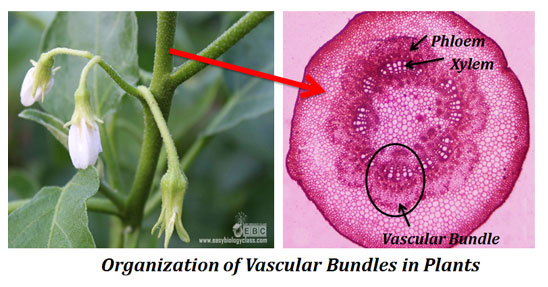
Types of Vascular Bundles
Vascular bundles are classified based MANY criterion.
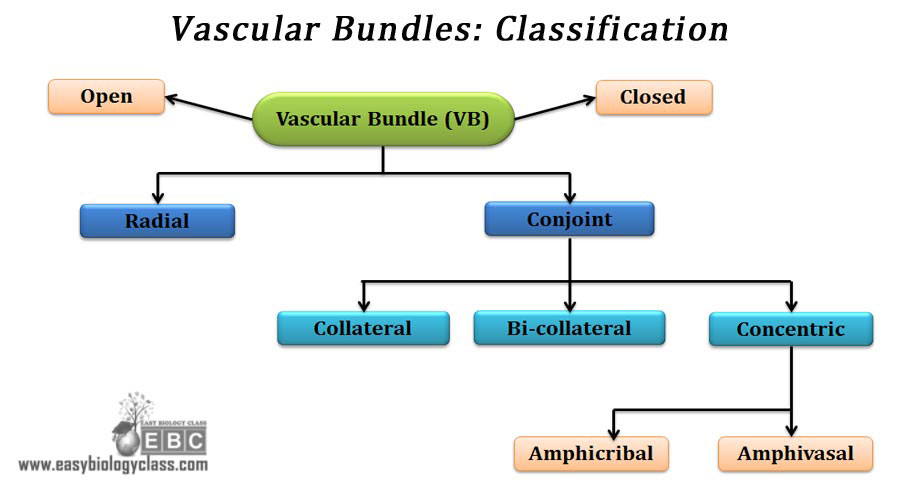
.
(1). Based on presence or absence cambium/secondary growth
1. Open vascular bundles
2. Closed vascular bundles
Cambium is a meristematic tissue responsible for secondary growth in plants.

In open vascular bundles a layer of cambium will be present between the xylem and phloem and thus they shows secondary growth. The word –open- literally means ‘open for secondary growth. Open vascular bundles are the characteristic of dicotyledons (dicots). The cambium present between xylem and phloem is called FASCICULAR CAMBIUM.
In closed vascular bundles, the cambium will be absent (fascicular cambium absent) and they do not show secondary growth (closed for secondary growth). Closed vascular bundles are seen in monocotyledons (monocots)..
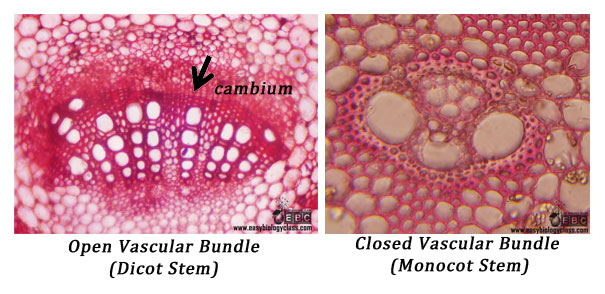 .
.
(2). Based on arrangement in the plant body
1. Radial vascular bundles
2. Conjoint vascular bundles

In radial vascular bundles the components are arranged separately (truly they cannot be called as bundles). Here the xylem and phloem are arranged SEPARATELY in different RADII. Radial vascular bundles are typically found in the ROOTS of monocots and dicots.
Typical vascular bundles are conjoint vascular bundles. Here the xylem and phloem are arranged TOGETHER in the same RADIUS. Conjoint vascular bundles are seen in STEM and LEAVES.
Three types of conjoint vascular bundles are seen, they are:
(a). Collateral vascular bundle
(b). Bi-collateral vascular bundle
(c). Concentric vascular bundles
(a). Collateral vascular bundles
A type of conjoint vascular bundle where xylem is arranged towards the interior (adaxial) and the phloem arranged towards the exterior (abaxial). Collateral vascular bundles are the most common type of vascular bundle. They may be open or closed based on the presence or absence of cambium within them (and secondary growth).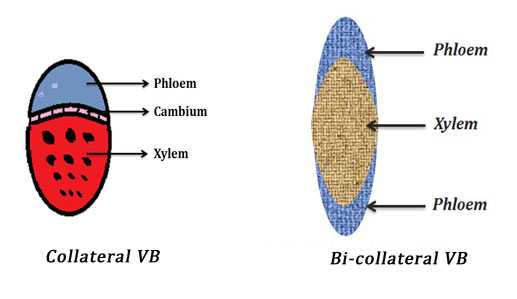
(b). Bi-collateral Vascular Bundles
In this type of conjoint vascular bundle, phloem is present in two groups, one outside the xylem and the other inside the xylem (i.e., xylem is located between two strands of phloem). Bi-collateral vascular bundles are characteristic of some Angiosperm families such as Cucurbitaceae (Cephalandra, Cucurbita).
(3). Concentric Vascular Bundles
A type of conjoint vascular bundle with one vascular element completely surrounds the other. Either the phloem surrounds xylem or the xylem surrounds the phloem.
Concentric vascular bundles are of two types:
(i). Amphicribral (hadrocentric) vascular bundle
(ii). Amphivasal (leptocentric) vascular bundle
 (i). Amphicribral (hardocentric) vascular bundles
(i). Amphicribral (hardocentric) vascular bundles
In amphicribral or hardocentric vascular bundle, the xylem is located at the centre surrounded by a ring of phloem. Example: Meristeles of Ferns, small vascular traces of flowers, fruits and ovules.
(ii). Amphivasal (leptocentric) vascular bundles
In this type of concentric vascular bundle, the phloem is located at the centre, surrounded by a ring of xylem. Example: Dracaena stem, Rumex and Begonia.
| You may also like NOTES in... | ||
|---|---|---|
| BOTANY | BIOCHEMISTRY | MOL. BIOLOGY |
| ZOOLOGY | MICROBIOLOGY | BIOSTATISTICS |
| ECOLOGY | IMMUNOLOGY | BIOTECHNOLOGY |
| GENETICS | EMBRYOLOGY | PHYSIOLOGY |
| EVOLUTION | BIOPHYSICS | BIOINFORMATICS |
Functions of Vascular bundles
The prime function vascular bundle is the conduction of water and food materials in the primary growth stage of plants. Xylem transport the water absorbed by roots to the leaves, whereas the phloem transport food materials form leaves (photosynthetic products) to all part of the plants including roots. Vascular bundles also provides mechanical support (a mechanical tissue) to the plant.
| You may also like... | ||
|---|---|---|
| NOTES | QUESTION BANK | COMPETITIVE EXAMS. |
| PPTs | UNIVERSITY EXAMS | DIFFERENCE BETWEEN.. |
| MCQs | PLUS ONE BIOLOGY | NEWS & JOBS |
| MOCK TESTS | PLUS TWO BIOLOGY | PRACTICAL |

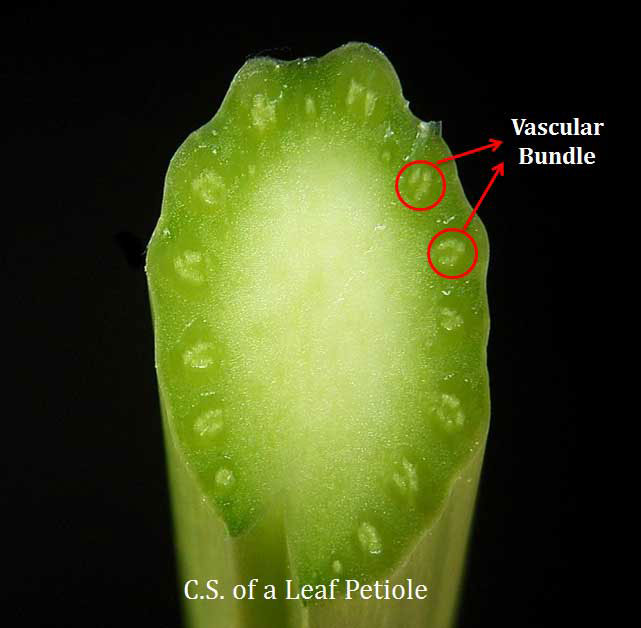
 (i). Amphicribral (hardocentric) vascular bundles
(i). Amphicribral (hardocentric) vascular bundles